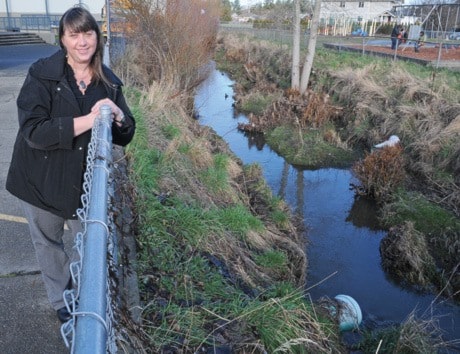On a bright, crisp January morning, the ringing of a bell signals the start of recess at St. Patrick’s elementary.
About 15 seconds later, a steady stream of students emerges from the building.
Laughing and shouting, the children make their way over a bridge to the playground. Few, if any, seem to notice the gently flowing water of Bowker Creek below, nor do they acknowledge the paddling of ducks on its surface.
St. Patrick’s is just inside the Victoria municipal line; its schoolyard spills over into Saanich. A few hundred feet to the east lies Oak Bay.
Nowhere else in the Capital Region do the three municipalities intersect in this way.
It’s fitting, then, that the creek flows through this spot. The narrow channel plays a vital role in all three communities.
A recently-adopted 100-year plan for the watershed will shape future development and conservation efforts in and around Bowker Creek.
A blueprint for the future
In 2003 the Capital Regional District and the three municipalities agreed to join with the community to create a watershed management plan for the creek. Stakeholders such as B.C. Hydro, the University of Victoria, Camosun College and several schools, including St. Patrick’s, contributed to the discussion. The result was the Bowker Creek Initiative.
“To be able to truly do some effective restoration of the creek, we all need to be working together,” says Jody Watson, the CRD’s harbours and watersheds co-ordinator, who also serves as chair of the BCI steering committee.
The creek is home to a variety of plants and animals, but over time, urbanization has reduced its habitability. It has been years since fish were found here – 60 per cent of the creek is routed through underground culverts, whose concrete bottoms don’t support life.
Development has also minimized the watershed’s role, eliminating areas where rainwater once seeped into the ground.
This leads to a “flashy” creek during heavy rains, increased erosion and further reduced natural habitats.
So what could the watershed look like for future generations, and what steps are required to get there?
The answers are the basis of the Bowker Creek Blueprint, a vision of the next 100 years for the watershed.
“It took 100 to 150 years of agricultural development, and then urban development, for the creek to get to the state that it’s in. We’re not going to be able to fix that overnight,” Watson says.
With the Blueprint in place, steps are being taken to do just that, and restore the watershed to a state where it can be a key part of a greener community.
A co-operative vision
To make the Blueprint a reality, it will take a co-operative effort. “We were saying how great it would be if instead of doing this in small parcels we could have a co-ordinated effort to maybe look at this holistically,” says Saanich Coun. Paul Gerrard.
Along with fellow Saanich councillor Vic Derman, Gerrard recently invited Victoria and Oak Bay councils to discuss the creation of common development permit guidelines for the watershed.
The details of those discussions have yet to be determined, but the three municipalities have agreed to participate.
That alone suggests a recognition of the issue’s importance, says Soren Henrich, who sits on the BCI steering committee as a representative of the Friends of Bowker Creek, whose members live within the watershed.
“We need a balance between urban and natural and rural landscapes for our community health,” he says.
Saanich and Victoria have incorporated the Blueprint into their official community plans, and Oak Bay will look at possibly doing the same when it completes its own OCP review over the next year or so.
Meanwhile, work is already underway to improve the state of the watershed. Rain gardens, which allow water to seep through the ground and into the creek, rather than running off roads and sidewalks, have been installed in Victoria and Saanich.
The redevelopment of Oak Bay High, which borders the creek, must take the watershed into consideration, says Coun. Pam Copley, who chairs Oak Bay’s municipal planning section.
“This will be one of the items on the table, a very important one.”
Work just beginning
The next century holds many possibilities for the watershed. More rain gardens, the establishment of transportation corridors known as greenways, and perhaps even bringing the creek out from underground in some areas – a process known as “daylighting” – are all on the table.
The Bowker Creek Blueprint has been endorsed by Victoria and Saanich councils.
Oak Bay hasn’t done so yet, but the municipality supports most, if not all, of the document’s guiding principles.
“It’s important to work with municipal partners to celebrate and manage places like Bowker Creek,” Copley says.
Gerrard recognizes the process of rehabilitating the creek for future generations is one which will far outlast his or anyone else's political career. That's why the agreement to discuss common development permit guidelines is an important one.
"I just want it kept on the burners so that we don't just forget about it and bury it somewhere in a file," he says.
"I think there's a real opportunity here for all three jurisdictions to be able to work together and get something really positive happening."
The scenario bodes well for students at St. Patrick’s, who continue to laugh and shout on the banks of the creek.
reporter@vicnews.com
Bowker bites
• The headwaters of Bowker Creek are found on University of Victoria campus
• In the mid- to late 19th century, the creek was known as the Thames
• It was eventually renamed in honour of John Sylvester Bowker, who owned a farm bordering the creek
